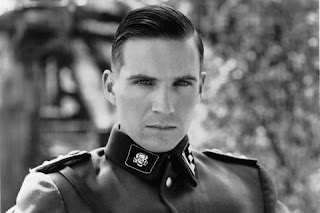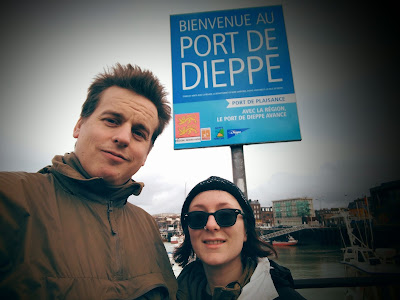Sometimes we give into culture and history, and sometimes it finds us. We had been travelling downwards towards Turkey, and found that our path crossed Auschwitz. This was something that was a rather interesting coda to the Wernigrode and Berlin monuments (or lack of them, in the case of the former town), and so we went with Mo, our Warmshowers host, to Auschwitz itself.
Auschwitz is a strange experience, in that it is both at once more and rather less terrible in appearance than one is led to expect. I know the Auschwitz and wider concentration/death camp system of history books and of film. It is steeped in black and white, often with good looking yet sinister SS officers (hello, Ralph Fiennes, you make me remember that my bisexuality has merely descended to hetroflexibility rather than entirely died away). It's rather striking when one looks at the fictional Amon Göth versus the real:
 |
| Fiennes as Amon Göth |
 |
| Actual Amon Göth |
Fictional Nazis are often presented as effortlessly oozing power in, ironically, a way that bears more resemblance with Leni Riefenstahl and
Triumph of the Will than the rather quotidian, dumpy functionaries that populate the photos taken at the time.
So, oddly, it seemed to me with Auschwitz I. It had no mist, no foreboding clouds, and no sombre music. It had a guide with a rather oddly vaudeville delivery ("ladies and gentlemen, the next room will shock you to your very core. You may take pictures.") and a notable emphasis on the Polish victims over the Jews that I suspect comes from the Polish government running the museum, but aside from that it was largely a reasonable quality set of barracks on a lovely summer's day.
 |
| The famous gate, and the tour group in front beyond. |
 |
| Confiscated glasses, taken for resale |
The buildings were erected by the Polish army previously, and I was struck by the utter normality of the complex as a piece of military architecture. I've walked around British army bases that were roughly the same. Even the gas chamber is surprisingly compact, and the furnaces for burning the bodies are rather limited. It looks, more than anything else, normal. In a way, that's the most imposing thing about it. It is not a place of special doom, it is merely the relatively normal place that was selected for an almost unimaginably amoral place of destruction. It had a room full of the hair extracted from the dead, and also had a snack bar. Hannah Arendt has talked about the banality of evil, but the thing it made me think was more the presence of the possibility of evil in all places, and the horror of the knowledge that the men who caused so many deaths did so as relatively ordinary men, in relatively ordinary places. Auschwitz I was a tool; a useful barracks complex that was made something more by the actions of those who put it to use. It's a strange graveyard for so many deaths.



Auschwitz II–Birkenau is more immediately striking, and the train line into the camp is immediately recognisable. The huts have been reconstructed, and the sheer density of the population that existed in the camp (around 90,000) is shocking. We were told that the entire complex was bare of grass due to the fact that any grass was immediately eaten, and there's a litany of horror that continues and continues as you walk past the selection ground towards one of the old gas chambers. Both places were places where the weight of history weighed on all three of us, and standing at the place where hundreds of thousands of people's ashes were dumped the sunny day and dappled sunlight on the bare ground seemed incongruous.
 |
| The pit where the ashes were dumped |
It's a strange thing to stand there with Jewish relatives in my family, and I can only imagine what it was like for Mo as a German. We stood there by the pit, and I found myself watching a little bird strut around that the side, full of life even in that place. It felt like a strange juxtaposition of life and death, much as the complexes did in general. The camps have become an oddly commercialised horror, and I found something strangely hopeful in that; they serve not only as a reminder of what can be done in the name of ideology but also gave me a sense that even the Nazis eventually wind their way towards history's eventual ignominy with Ozymandias.
A postscript of moderately intense weirdness: it's impossible to visit the house attached to the camp that Rudolf Höss lived in as camp commandant, but not for any reasons of taste or because of a concern that Höss might be humanised. No, it is lived in by an apparently normal family, and is out of bounds because the family dislike being peered at. I cannot fathom the desire to live there, and to look out on the camp every day over supper. Unlike them, we were affected, and although it was fascinating the mood of the party only lifted again as we left.










Comments
Post a Comment